Complete Guide on Cast Iron Cookware
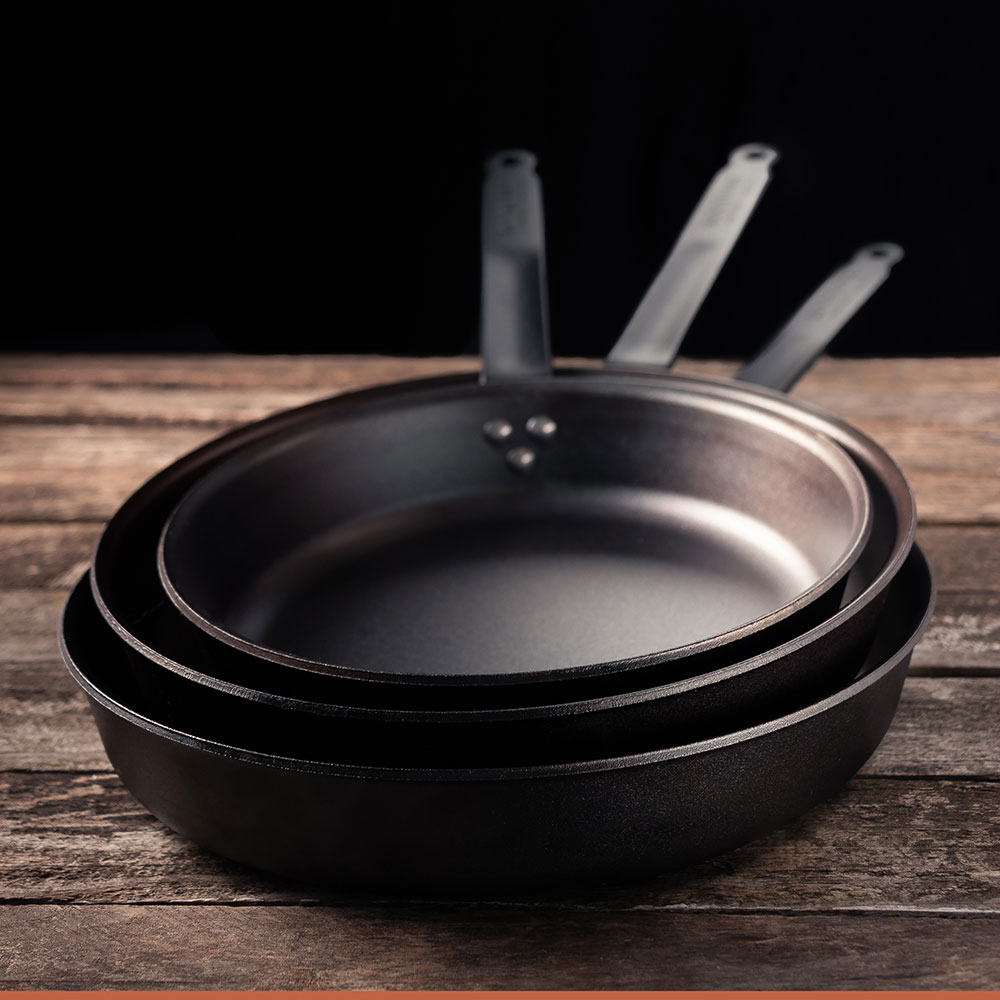
-
Darrian Wilkins
- Last update: February 18, 2022
Disclaimer: we may receive commissions from purchases made via our links at no cost to you
Carbon steel cookware has been used for centuries and it has always been one of the preferred choices for professional chefs and restaurant cooks because it’s durable enough for heavy-duty use and performs well with nearly all heat sources. Beyond just the professional chefs and their kitchens, carbon steel cookware has been making its way into home kitchens. Home cooks love it for its versatility as it’s suitable for almost all sorts of cooking and even baking purposes.
But what makes it really special in contrast with other cookware like stainless steel, copper, aluminum, and cast iron? What kind of heat sources can you use with it? Is it safe? What types of food can you cook in it? These are certainly questions that might be running in your mind right now as you think about carbon steel cookware, right? Well, here we’ve the answers to all these questions and much more, so read on to learn more.
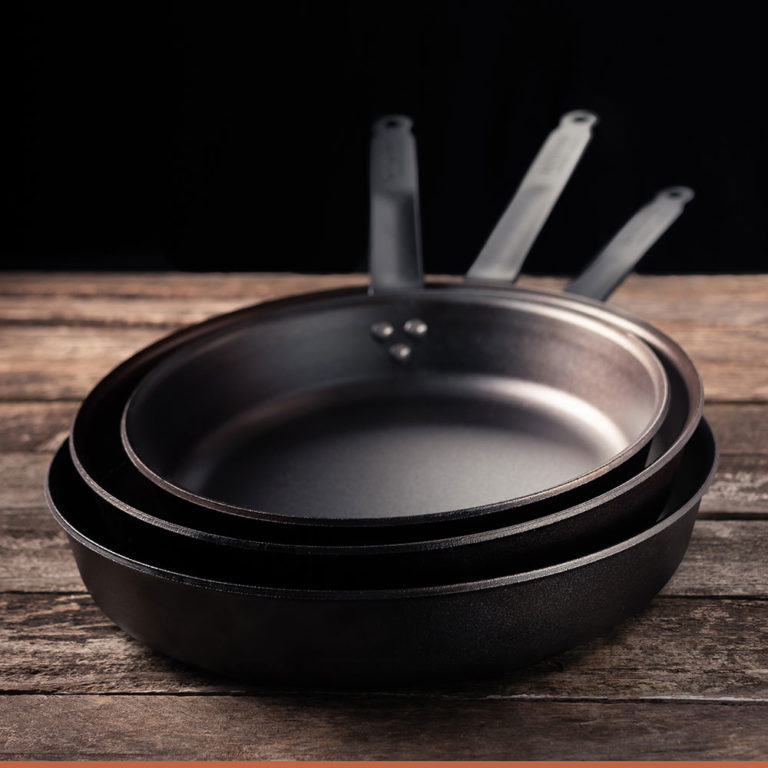
What is carbon steel?
Carbon steel is probably one of the most used materials on the planet. It first appeared in around 500 AD in Damascus steel swords and also in Japanese swords. It’s generally believed that the first instances or creations of carbon steel happened by accident as ancient swordsmiths used iron ore as the primary metal for crafting swords.
Since iron needed extreme heat to smelt it, the smiths used mainly coal to generate it. The coal introduced trace amounts of carbon into the molten metal, resulting in a new iron alloy, the carbon steel.
With that bit of history in mind, arbon steel is basically an iron-carbon alloy (like other steels), with a carbon content of about 0.05 up to 2.1 wt. % – the rest is iron. It’s one of the primary types of steel and the variation in its carbon concentrations (0.05 to 2.1%) results in different grades that we’re going to look at shortly.
Beside carbon and iron, carbon steels only have trace amounts of other alloying elements, although they usually contain manganese. The maximum content of manganese and silicon must not exceed 1.65 wt. % and 0.6 wt. %, respectively. The copper content must also not exceed 0.6 wt. % or be less than 0.4 wt. % for a material to be carbon steel.
There’s no minimum content requirement for cobalt, chromium, nickel, vanadium, titanium, tungsten or other corrosion-resistant metals.
Due to its strength and the fact that it’s cheap to manufacture, carbon steel accounts for 90% of all steel production. Companies often manufacture it in massive quantities as it’s the most widely used construction material, used by engineers on large scale industrial applications, including civil and mechanical construction, agricultural equipment, and auto parts.
It’s used in many other applications including furniture, tubes, and household appliances, like making knives and of course, cookware. Its composition makes it a particularly suitable and functional material for cookware – its slightly less carbon content compared to cast iron makes it less brittle hence it can be made fairly thin and lightweight yet still be very durable. Its major downside though is that it’s significantly more prone to corrosion.
Benefits of carbon steel
Carbon steel offers several benefits as a material for making cookware compared to stainless steel and its close cousin, cast iron. The main benefits include:
1. Light in weight
In contrast to stainless steel or cast iron, carbon steel is thinner and lighter, mainly due to its low carbon content. It’s basically around 40% lighter than cast iron. For instance, while a 10-inch cast iron skillet weighs about 6 pounds, a carbon steel skillet of the same size weighs around 4 pounds or slightly less.
The high carbon content in cast iron makes it brittle and as such, it has to be thicker in cookware because it would break if it were thinner. It’s this thickness that makes it heavier and less maneuvrable compared to carbon steel, which is less brittle, meaning it doesn’t need to be made thick to be strong hence its light weight. This lightweight nature makes it easier to handle and use. It offers better maneuverability on the stovetop than cast iron. You can turn, flip, and shake a carbon steel pan easily while cooking or move it effortlessly from a stovetop to an oven.
2. Natural non-stick surface
Like cast iron, carbon steel cookware can build up a natural non-stick coating when seasoned with oil. The effectiveness of this non-stick surface is nearly comparable to artificial or chemical coatings. In fact, it’s much better than the non-stick properties of seasoned cast iron cooking surfaces. Cast iron has a grainier surface, so it’s rough and offers an only relatively effective non-stick surface once seasoned.
However, carbon steel has a more uniform texture which makes its surface smoother and easy to develop a slick patina when seasoned. This slick patina coupled with the smooth surface makes its non-stick properties much better than a perfectly seasoned cast iron cookware.
3. Tough and Durable
Just like cast iron, carbon steel cookware is very durable. With the right maintenance and care, you can use it for many years without damage. The small percentage of carbon gives it more tensile strength and hardness – the lesser the carbon content mixed with iron, the stronger and less brittle the carbon steel pan or skillet would be. So, it’s not only strong and hard, but it’s also relatively ductile. It can withstand great stress without actually breaking. It can bend when not handled carefully, but it certainly won’t break. If it had more carbon like cast iron, it would be much more brittle hence easier to damage or break.
4. High Heat Tolerance
Carbon steel can handle high temperatures for long periods, a feature that’s again attributed to its low carbon content. You can crank up the heat and leave your pan on the stove, oven, or broiler for extended periods without damaging it. Exactly how much heat can it tolerate, you may ask? Well, most carbon steel pans are able to handle up to 800°F, but there are some that can withstand as high as up to 1200°F. This high heat tolerance is especially useful when cooking steaks, burgers, or other meats that need intense heat in order to get a good sear.
5. Heats up Fast
The other great advantage of carbon steel cookware is that it heats up relatively quickly. While its thermal conductivity (54 W/m K) is almost similar to that of cast iron (52 W/m K), its thin design (available at around 2 to 3 mm of thickness) allows the heat to transfer from the cooktop to the surface faster. Compared to copper (413 W/m K) and aluminum (237 W/m K) cookware, it’s not better but against stainless and cast iron, it’s much faster.
For instance, a cast iron cookware may take 10 to 30 minutes to preheat, whereas carbon steel would take only 3 to 5 minutes, which is nearly half the time, so there’s a significant difference. Moreover, unlike cast iron, the heat distribution is uniform across the surface of carbon steel cookware hence there are fewer hot spots, allowing foods to cook more evenly and efficiently.
Another bonus is that carbon steel cookware cools down quickly. This comes in handy when cooking delicate ingredients, plus also saves you time because you don’t have to wait so long for it to cool down before cleaning.
6. Fairly Responsive to Heat Changes
Finally, carbon steel responds faster to temperature changes than cast iron would, which gives you great control when cooking or baking. When you turn the knob or temperature dial to go from low to high or from high to low heat, you don’t wait for minutes for the cookware cooking surface temperature to change. The response is quick, helping you avoid undercooking or overcooking your meal.
Types of carbon steel
Carbon steel is typically classified into three main categories: low, medium, and high carbon steels. The key difference between them is the amount or level of carbon content in them which ultimately causes their microstructure and properties to vary too.
Medium Carbon Steel
Also known as mild steel, the low carbon steel has 0.05 to 0.3 wt. % carbon concentration. It’s generally the most widely used type of carbon steel in making cookware due to its cheapness and the fact it has high ductility due to the low carbon content hence it’s easy to weld, bend, cut, and shape into different forms. It’s equally moderately strong in contrast to the other steels with higher carbon levels.It has just enough carbon concentration to make it hard and pretty durable, but not brittle.
These properties make it the perfect option for many other tasks that require strength and shaping (form into structural shapes). It’s used in structural applications (building construction, bridges, and even transmission towers), automobile body components, ship building, railings, domestic appliances, and more. It’s also what is frequently used to make eating utensils like spoons and forks.
White Cast Iron
Medium carbon steel has slightly higher carbon concentration (0.25 to 0.70 wt. %) than low carbon steel and it contains some manganese content (around 0.60 to 1.65 wt. %) as well, which also contributes to its properties. It offers a balance between the low and high carbon steels, providing greater strength and hardness compared to low carbon steel while still being more ductile than the high carbon steels. Its mechanical properties can be further improved through heat treatments (such as quenching and tempering) in applications where greater hardness and toughness are required.
High carbon steel
High carbon steel is also referred to as “carbon tool steel” and its widely used to make knives due to its superb strength and hardness. It has the highest carbon composition of the three types, at around 0.60 to 1.5 wt. %. It as well has a manganese content of 0.30 to 0.90 wt. %. It provides the greatest strength and hardness in contrast to the rest, making it ideal for applications like making chiseling tools, springs, punches, high-strength wire, drill bits, and more. It’s, however, much harder to form or machine since it’s less ductile.
How carbon steel cookware is made
Carbon steel cookware is mostly made of 99% iron and 1% carbon. The carbon steel itself can be produced from a number of materials including virgin steel, recycled steel, or a combination of both.
The virgin steel is basically made by combining an iron ore (pig iron) with lime and coke in a blast furnace at temperatures of around 3002 °F (1650 °C). The molten iron that’s extracted from the iron ore has high carbon content from the burning coke whereas the remaining impurities present in the mixture combine with the lime, forming slag which floats on the top of the melted metal where it’s extracted.
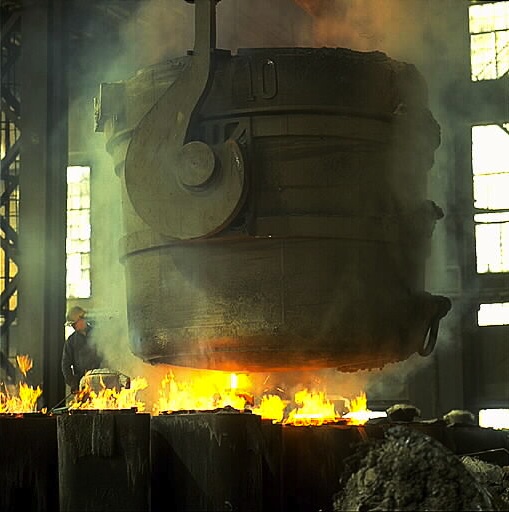
The resulting molten steel has roughly 4 wt. % carbon, which is reduced to the desired amount (around 1 wt. % or less) in a process known as decarburization where oxygen is passed through the molten steel upon which it oxidizes the carbon in it, producing both carbon monoxide and carbon dioxide. The steel is then allowed to gradually solidify into a rectangular shape or slab which is usually brought further down to the desired size through processes known as hot rolling or cold drawing.
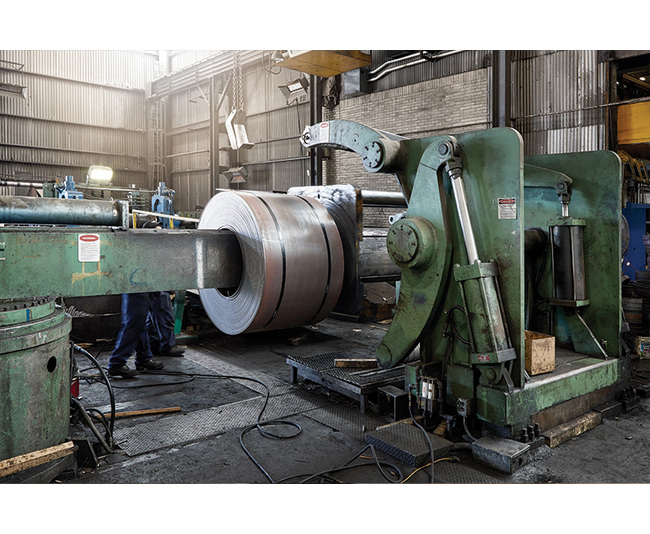
The actual process of making the cookware is quite different from that of cast iron. Whereas in cast iron molten iron is poured into casts or molds shaped according to the cookware you want to make, in carbon steel, the cookware is made from carbon steel sheets which are pressed into the form/shape of the pan or pot.
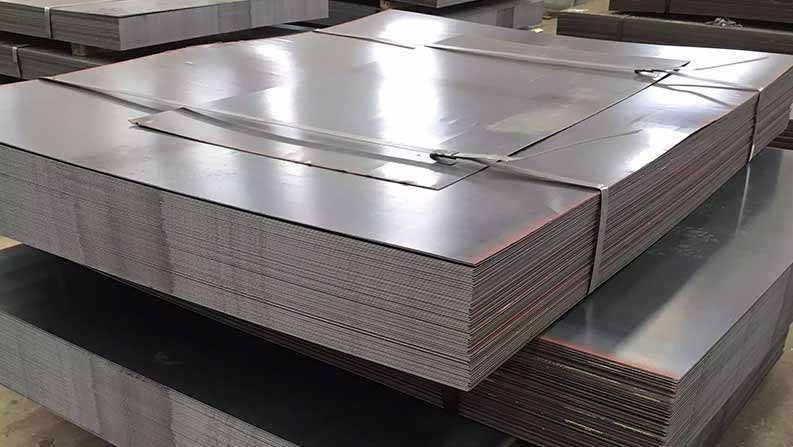
The process starts with a perfect square of thick iron that has been heat treated to resist corrosion and rust. From there, that square is trimmed into a perfect circle and then punched/stamped into your pan’s body. After the body is made, the handle is attached with three French rivets that can withhold one ton of weight. This keeps the handle and the pan lasting forever.
Handles for carbon steel cookware
The handles of carbon steel cookware are made separately and then attached to the rest of the cookware, unlike cast iron where the cookware comes as a single solid piece, including the handle (it’s integrated with the cookware). The handles are usually made from the carbon steel itself, though sometimes they are made of cast iron for added strength or stainless steel as it remains cooler than carbon steel during cooking.
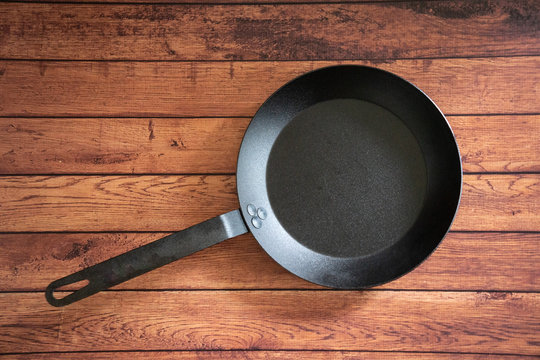
These handles are either welded or riveted in place. Both methods make for a solid and very strong attachment although not really for so long. The rivets tend to work themselves loose over time, while the welds can break. At least for the rivets, you have some warning (when they become loose) before they break. For the welds, they can seem okay all the way until the point where they break suddenly – potentially with a bunch.
In terms of design, the carbon steel handles are generally long and flat (mostly bent to be slightly concave). Although some can be a little short, the long design provides good leverage, especially when lifting the pan, pouring, and doing a 2-hand flip – you can easily hold them with two hands. The long handles also help slow heat transfer when cooking for long periods.
On large carbon steel cookware, a secondary handle (often known as a hanging loop) is attached opposite to the main handle (again riveted or welded). It’s meant for hanging up the pans but it’s also very useful for extra control, especially when carrying a pan full of liquid.
Unfortunately, whether long or made of stainless steel, carbon steel handles do get very hot as they are often bare. You have to use oven mitts, pot holders, a cloth or any other heat insulator when holding the pans or pots. Some though can occasionally have plastic heat proof covers or silicone grip slipped onto the handle. These materials don’t conduct heat hence allow the handles to remain cool enough to touch when using the cookware on the stovetop
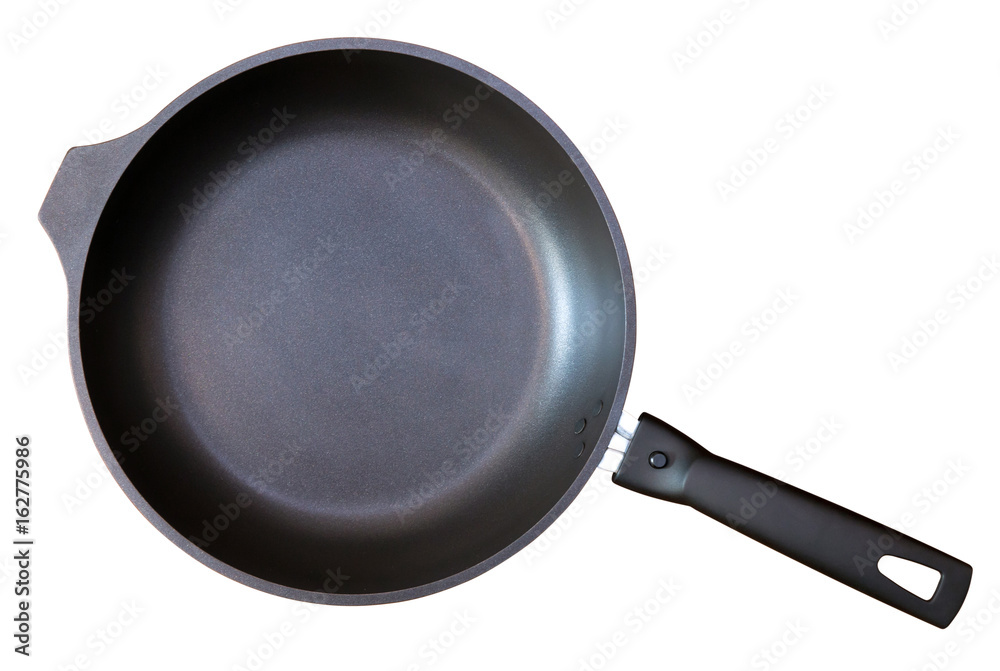
There are also some carbon steel cookwares that feature a short round bracket that’s riveted to them and then a wooden handle is attached. Generally, these are often found in carbon steel woks, but there are pans that can have wooden inserts in the steel handles. All these heatproof covers though cannot withstand very high heat, so you can’t really use the carbon steel cookware in the oven or on a direct flame.
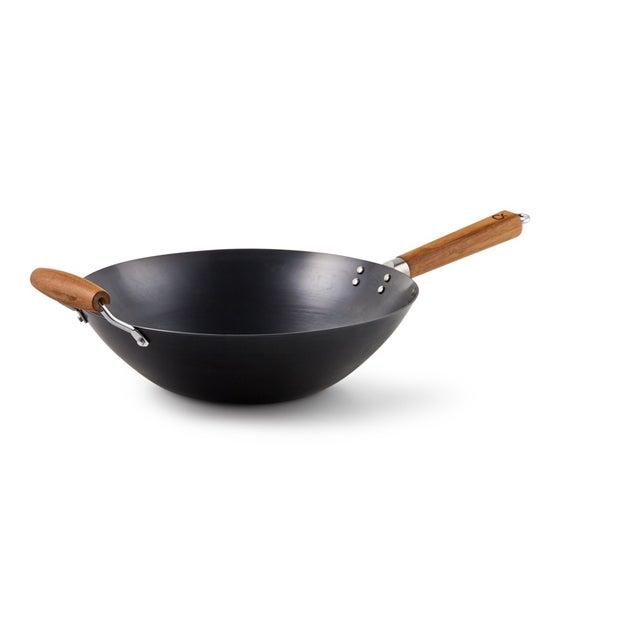
Heat sources you can use with carbon steel cookware
One of the advantages of using carbon steel cookware is their compatibility with not just different heat sources but also every type of cooktop. It can be used on gas, electric and even induction cooktops. You can also use it in the oven, broiler or on grills and smokers, or even over a campfire. This versatility is what makes carbon steel cookware quite popular in restaurant kitchens. Below is how it performs with each type of heat source.
Gas stovetops
Most chefs around the world cook on gas ranges and this is one of the reasons why they often prefer carbon steel cookware over the others. If you have liquid propane (LP) or natural gas cooktop, then carbon steel cookware might be your best option too. These gas cooktops can produce high temperatures very quickly and they require a cookware that can withstand such abrupt high heat without damaging. Well, carbon steel no doubt can withstand these temperatures and even abrupt temperature changes for many years without serious damage. The only issue is that it may ultimately develop an uneven bottom.
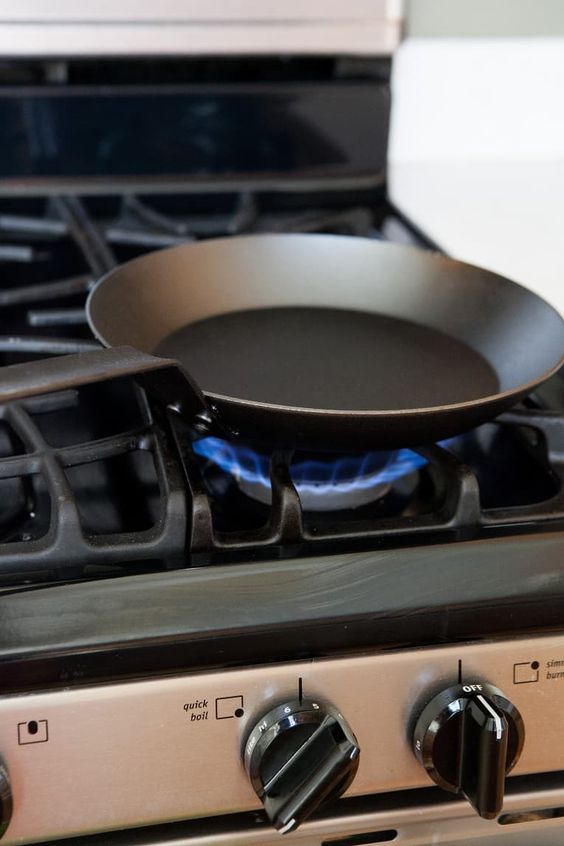
Electric stovetops
Carbon steel pans and pots will work on electric stovetops, whether it’s the electric burner or the electric glass stovetop. Their bottom may or may not be completely flat like stainless steel but they are more conductive, so they heat up relatively quickly even with electric cooktops being quite slow to heat up and they also distribute heat more uniformly even in areas or spots that are not directly touching a burner. They can as well respond effectively to the erratic temperature changes which electric cookers are known for.
Given that they are lightweight and generally have a fairly smooth surface than cast iron, carbon steel cookware can work pretty well on electric glass stovetops. However, it can still wear or rub on certain spots on the delicate glass surface if caution is not taken when cooking or adjusting the pan or pot, especially considering that their bottom is not completely flat. Older carbon steel pans and pots that have worn down are also usually no longer smooth hence can certainly scratch the smooth surface of glass stovetops.
Induction
Induction cooktops can only produce heat when they are in contact with magnetic metals. Carbon steel is a ferromagnetic material (has high iron content), which makes it certainly compatible with induction cooktops.
As with electric glass cooktops though, induction cooktops have a smooth and polished glass surface that can easily get scratched by the bottom of an old carbon steel cookware that has worn down or even a new cookware if caution is not taken when cooking or adjusting the cookware.
Fortunately for induction cooktops, you can put a scratch protector mat, parchment paper, newspaper, or a tissue between the bottom of the cookware and the cooktop surface to protect the glass. Since induction uses just magnetic fields, the cooktop surface doesn’t actually get hot hence the paper won’t burn.
Oven and broiler
Carbon steel cookware thrive in the oven too provided the handle material is oven-safe. For this reason, most carbon steel pans or pots can go right from a stovetop to an oven or broiler, or vice versa. This ability makes the carbon steel pans versatile and especially nice for those cuts of meat that you might want to start with a sear on a stovetop and then finish in the oven. They can be used in both electric and gas ovens.
Besides these conventional heat sources and cooktops, you can use carbon steel cookware over a campfire or even on a portable burner when you are on a camping trip or just want to enjoy a meal out in nature.

Is carbon steel cookware safe?
This is a question that many nowadays ask when purchasing new cookware, especially because more and more people are becoming aware of the toxic materials that are on some of the nonstick cookwares in the market. If you’re also wondering about the same, the answer is yes, carbon steel is totally safe to use for either cooking or baking.
It’s composed primarily of carbon and iron, which are non-toxic elements that are very safe and healthy for cooking. They can hold up to high temperatures for a very long time without emitting or leaching any toxic substance. There are no pigments, chemical coatings, no nothing – only carbon and iron.
The only problem is that if you don’t season the cookware properly regularly or don’t use it well, it can get rust which is only oxidized iron and won’t really harm your health provided your body is able to safely deal with the excess iron. Much like cast iron cookware, carbon steel pans and pots are reactive to acidic foods. Therefore, you have to be wary of braising in wine, stewing tomatoes or simmering a tomato sauce in your carbon steel cookware (use your stainless cookware instead).
Utensils you can use with carbon steel cookware
You can use any utensil on carbon steel cookware as long as it can take the heat because the cooking surface can get really hot. Carbon steel itself is very durable and hard to get damaged easily. Some of the common utensils you can use are metal, wood, and high-temp silicone utensils. Each option has its strengths and weaknesses as described below.
Metal Utensils
Metal utensils like spatulas and turners are ideal for use on carbon steel cookware, especially when the seasoning is settled (like in a week or two). At this time, the seasoning is so non-stick and impervious, so the metal utensil will just slide under the food if you use it in a normal fashion – no digging at the seasoning or scratching it, unless now you scrap it with a lot of force.
Moreover, the seasoning is a continuous process. You’ll constantly add and subtract the non-stick coat, so any small scratch by the metal utensil is perfectly fine because it will fill in and again season over time as you keep using the cookware, and even get better and stronger.
Silicone Utensils
Silicone utensils can be used everywhere as they are affordable, widely available, and safe under high heat. They don’t leach harmful chemicals. They are basically non-reactive, non-corrosive, and chemically stable hence certainly won’t ruin the food, even when cooking very acidic foods or when there’s fluctuations of temperatures. They equally don’t stain much or keep the smell of the food.
Most importantly, silicon utensils can hardly scratch the seasoning/non-stick coat of the carbon steel cookware because they are very rubber-like and flexible. They are particularly ideal for newly seasoned carbon steel cookware. The only downside is that they may not be sturdy enough to deal with the heavy foods due to their flexibility.
Wooden Utensils
Wooden utensils are a great choice too for newly seasoned carbon steel cookware because they are soft enough not to harm the seasoning or the cooking surface of your cookware. They are also generally safe, inert, and poor heat conductors. They will stay cool even when cooking at high temperatures or when left in the cookware for long.
Furthermore, unlike silicone, wooden utensils are usually sturdy and durable, hence can be used with heavy foods. They are equally affordable and available just like silicone. The only major downside is that they can be difficult to keep clean, plus they usually absorb odor and can harbor bacteria.
Seasoning carbon steel cookware
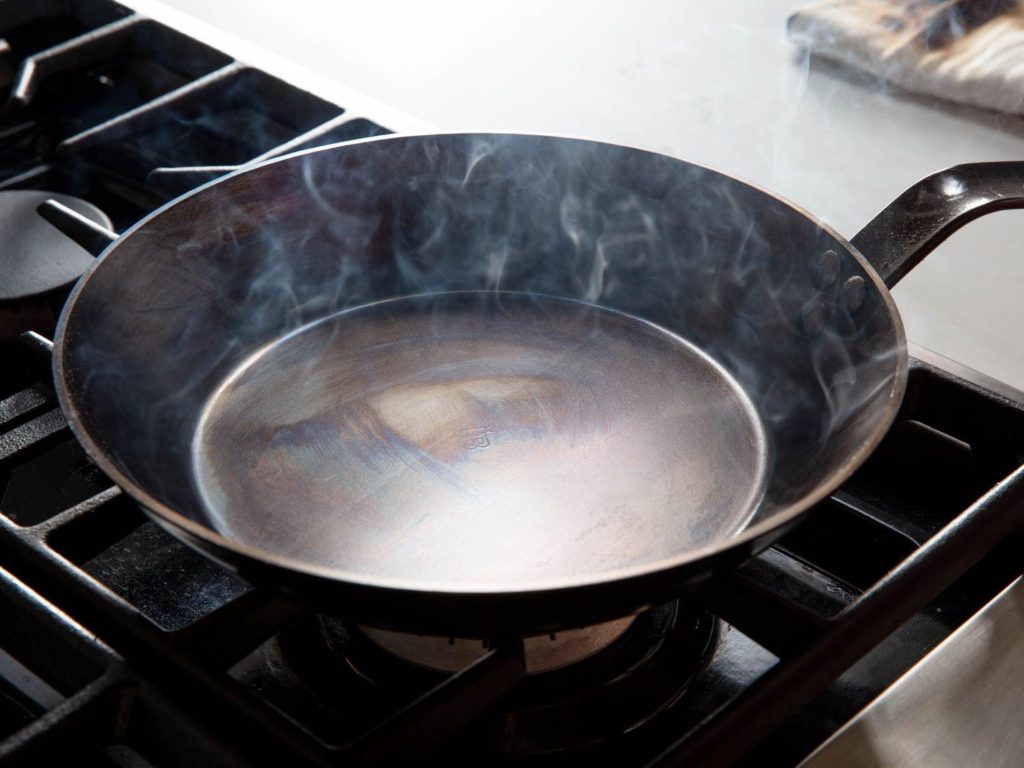
Like cast iron, carbon steel cookware needs to be seasoned before first use. This is crucial especially since most carbon steel cookware come completely unseasoned and raw, whereas most cast iron cookware come already pre-seasoned. Seasoning the cookware basically creates a barrier or coat that protects the bare carbon steel surface from getting in contact with water hence preventing it from rusting, even when exposed to humid environments.
In addition, the seasoning creates a smooth finish on the cookware’s surface that gives it a non-stick property that’s as effective as nonstick pans with Teflon coating.
The actual process is simple and can be completed within half an hour. All you need is some natural cooking oil, a paper towel, and a source of heat. The process goes as follow:
1. Start by washing your cookware thoroughly. Most new carbon steel cookware come covered with a coating that’s meant to prevent rust. So you have to first remove this coating according to the provided instructions as it can differ between manufacturers. If you are not sure, then you can use a kitchen sponge and hot water to scrub it off. After that, wash the cookware thoroughly as described in our cleaning section below.
2. Once the cookware is clean, dry it thoroughly right away using a dry kitchen towel. Run it over the surface of the cookware to pick up heavy moisture. You can then set the cookware on a cooktop over medium heat for a few minutes until all the remaining moisture has completely evaporated.
3. Before starting the seasoning, the cookware has to be at a very high heat in order for the oil to be applied as thinly as possible. So, crank up the heat to high and let the cookware heat for another minute. You can use a stovetop or even a preheated oven (heated to 450°F), provided the cookware handle is oven safe.
4. When the cookware has heated up, apply 4 to 5 drops of neutral oil on it and then spread the oil evenly all over its surface using a paper towel or kitchen cloth. Spread until the pan appears dry – not greasy, shiny, or wet. Take another dry paper towel and immediately wipe off all traces of excess oil from the cookware. There shouldn’t be any visible oil or wax traces on the cookware or else it won’t season evenly, and may form sticky patches or bumps caused by non-fully oxidized oil particles.
5. Now let the cookware heat up, either on a stovetop or in the oven. Let it heat until it starts to smoke and the oil turns to a deep brown patina. This may take several minutes (around 60 minutes), as the heat causes the oil to form a polymer. Once the cookware stops smoking and it’s free of any liquid oil, then the process is complete. The parts where the oil forms a solid layer should be slightly brown. You may have to move the cookware over the surface of the burner a bit to ensure more even heat so that the oil forms a polymer everywhere, especially if you are seasoning a wok. The walls will not season well unless you heat the sides over the flame.
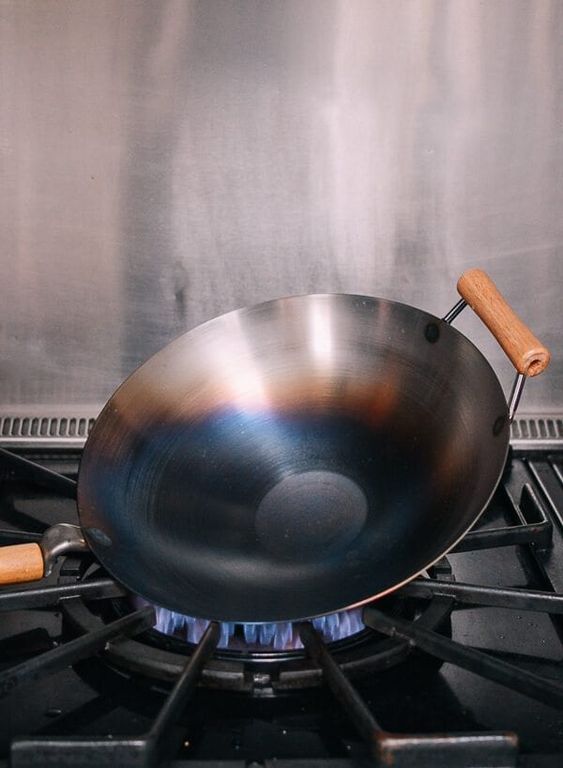
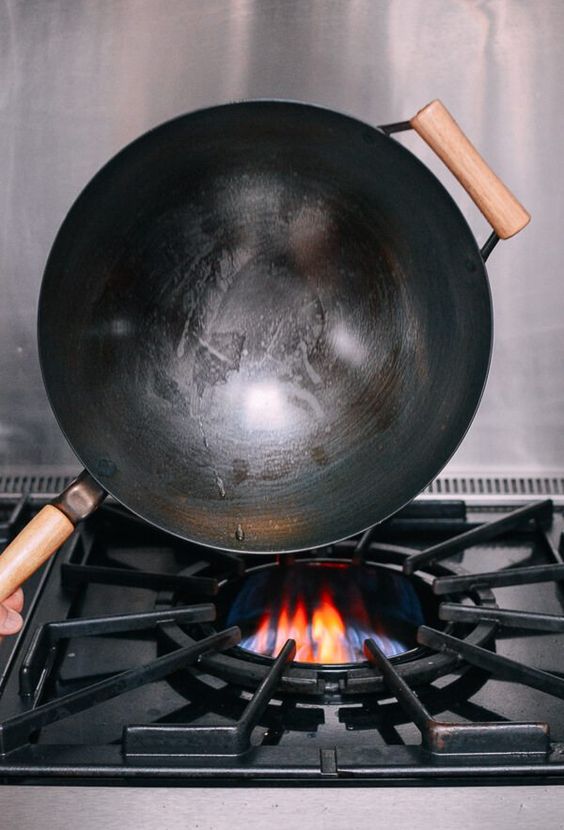
6. Repeat the two last steps again. Spread another coat of oil and wait for it to thoroughly polymerize. At least three coats are good for a new cookware, or until its entire surface acquires a dark deep brown color. That should be enough for you to start cooking.
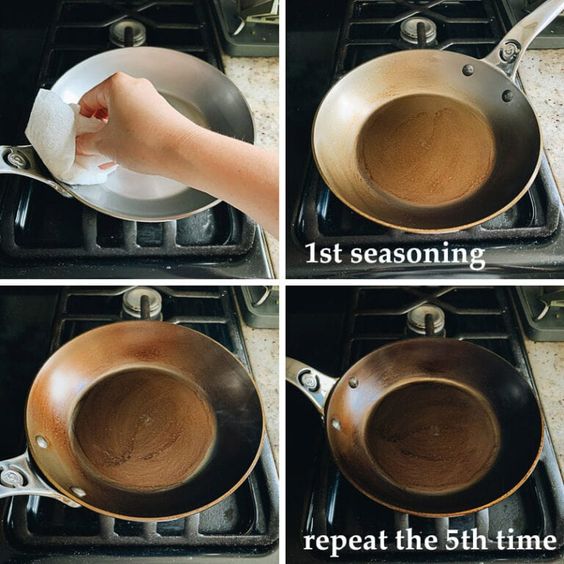
This process can be done with skillets, pans, or woks. Since the pores of carbon steel are smaller than cast iron, you’ll actually need less oil to create that perfectly seasoned surface that feels smooth to the touch. If you notice any roughness or stickiness, then you might have used too much oil, and as such you should scrub your cookware until it feels smooth, and re-season it.
The seasoning may flake off too while cleaning or cooking since it’s still a bit weak. If this happens, don’t worry. Just gently scrub off the loose flaking and then season the cookware a few more times. The flaking will stop as the seasoning becomes stronger over time.
What oil should I use for the seasoning
Well, the best type of oil for seasoning carbon steel cookware is neutral oil with a high amount of unsaturated fat (especially polyunsaturated fat) and a medium to high smoking point. Some of the ideal options include:
1. Polyunsaturated Oils
- Grapeseed oil: it creates the best quality seasoning due to its very low saturated fat level (10%), plus it has a high smoking point (420°F). It’s also cheap and it blends well with other flavors. It doesn’t leave a distinct taste that can outshine or overpower other seasonings or food flavors.
- Corn oil: it’s just as good as the grapeseed oil as it’s very low in saturated fat (13%) and has a high smoking point too (449°F). It’s equally cheap and doesn’t have a unique, lingering taste.
- Soybean oil: another fine choice that can yield good seasoning. Has fairly low saturated fat (15.1%) and high smoking point (453°F), plus it doesn’t have a strong flavor.
- Sunflower oil: offers the same great properties as corn oil (13% saturated fat and 449°F smoking point) hence will create a quality non-stick coating.
2. Monounsaturated Oils
- Canola oil: it’s neutral in flavor and has a medium smoking point (399°F). It also has one of the lowest levels of saturated fat (7%), although it’s very high in monounsaturated fat (64%).
- Vegetable oil: not really the best choice because it’s mostly a blend of several other refined oils and can have impurities that can affect the quality of the seasoning. However, it’s similar to canola oil in many ways: neutral flavor, same smoking point of 399°F, and very low saturated fat (6%) but high in monounsaturated fat (54%). It will work fine, but not as good as the rest.
Basically, you should avoid any oil with high saturated fat, low smoking point, and has a distinct or strong flavor. This includes olive oil, peanut oil, and coconut oil, along with lard, butter, and bacon. Some experts recommend flaxseed oil as the ideal choice but it’s great for seasoning cast iron, not carbon steel cookware. It has a low smoking point (225°F) and a unique smell that can be a turn off to some people.
Best foods to cook in carbon steel cookware
Carbon steel cookware like pans and woks can be used to make all sorts of delicious meals. They can literally do it all: searing, frying, sautéing, baking, smoking, and roasting. You can use them to prepare simple as well as much more complicated recipes.
Carbon steel pan
Browning and searing: carbon steel pans excel at browning and searing food. They heat quickly and transfer the heat uniformly to create deep, even browning just like cast iron. Their smooth cooking surface also provides great contact for searing. They are superb for searing thick-cut steaks but also work well for searing salmon filets, pork chops, and tuna. These pans are equally oven-safe hence they’re ideal for gently finishing off steaks and fish in the oven in case they’re not done to your liking inside.
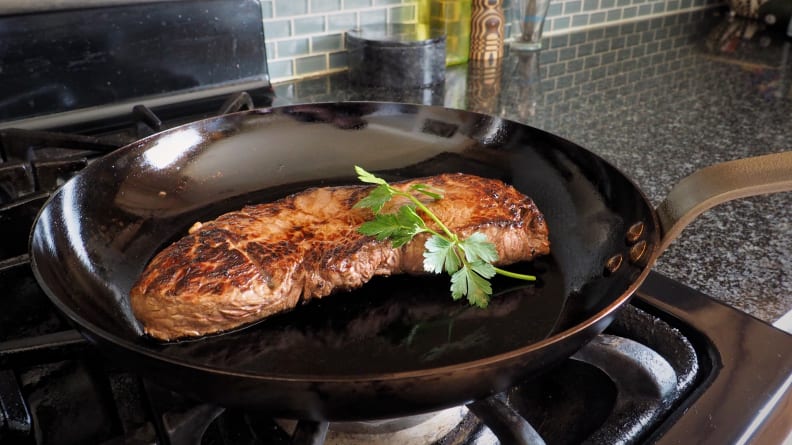
Crisping up chicken skin: you can achieve that irresistibly crispy skin with a carbon steel pan when cooking chicken, duck, or fish with skin. You just preheat the pan well and sear both sides nicely till golden brown and then finish cooking in the oven. The carbon steel pan will help to regulate the cooking temperature resulting in a tender, juicy golden-brown chicken or duck. It will also be just as good at crisping up hash browns and tofu as it is chicken, duck, or fish.
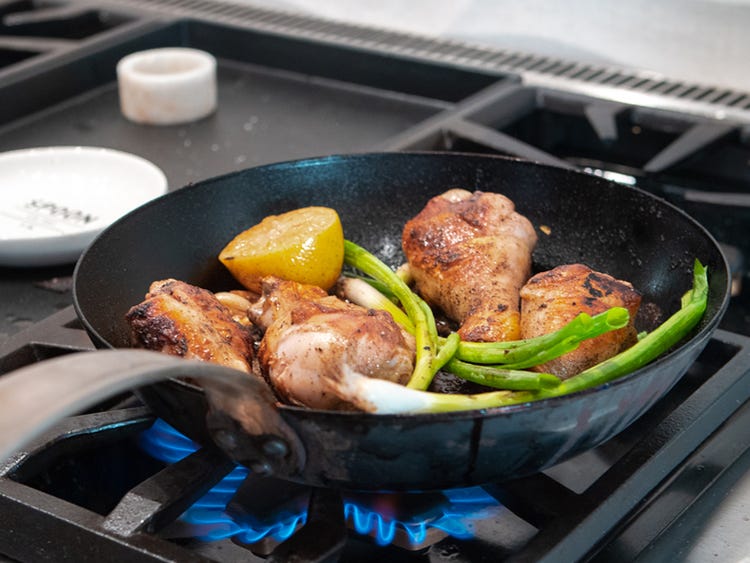
Sautéing: being lighter weight and having sloped sides, carbon steel pans are equally much better suited to sautéing foods. They are easier to lift, shake, and maneuver with just one hand, plus since the food moves around the pan constantly while cooking, the hot and cold spots don’t really matter as much. The sloped sides as well make in-pan tossing (something that chefs like to employ) of the contents while sautéing easier.
Shallow-frying: since they are able to distribute heat evenly, these pans are equally good for shallow frying foods, which is a cooking technique ideal for preparing serving-sized meats, fritters, and potatoes in a shallow pool of very hot oil or fat.
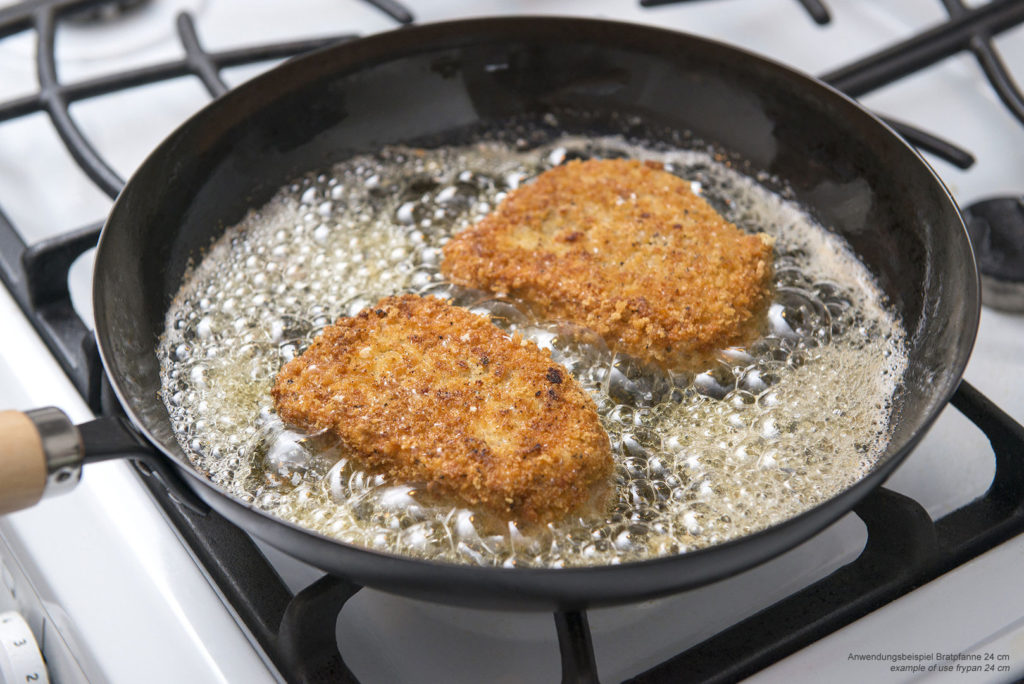
Stir-frying: the shallow sloped sides of a carbon steel pan make it ideal for stir-frying as well. If you need to prepare a fast meal that includes maybe delicious chicken sided with either vegetables or fried rice, it will certainly help you make that meal when it’s very well-heated. The shallow sides offer plenty of room for lots of stirring and also movement.
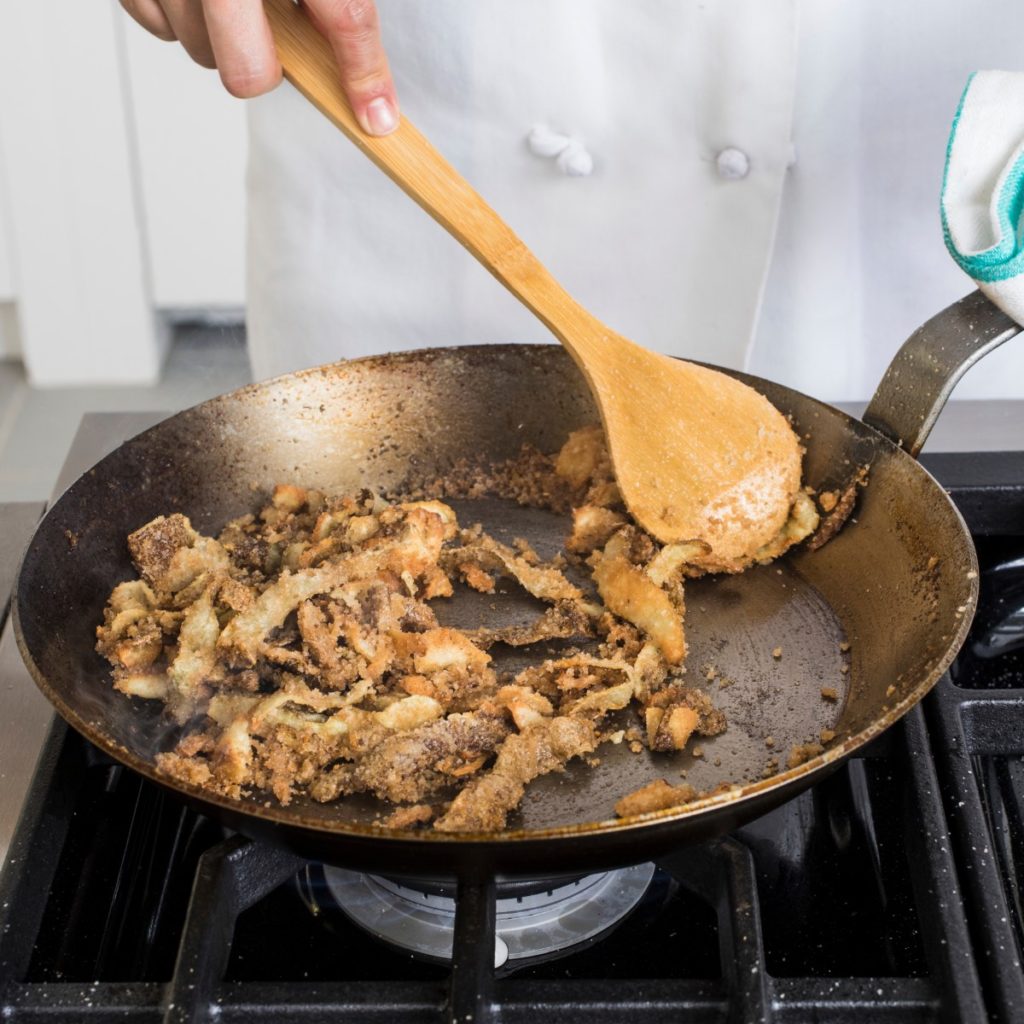
Baking: this may come as a surprise to you, but you can actually bake on your carbon steel pan because it can withstand high temperatures and go into the oven. You can bake cornbread with the pan on a stovetop or in the oven, or prepare some desserts like apple pie, which includes an oven in the cooking process. The apple pie filling won’t stick to the pan like on other types of pans when sugars caramelize. You can even prepare a pizza such as the Chicago-style deep dish pizza in your carbon steel pan.
Frying eggs and bacon: carbon steel pans are perfect for cooking eggs in whatever way you want – scrambled eggs, fried sunny-side-up eggs, or even the classic French or Spanish omelets. The evenly distributed heat and nonstick surface allow you to cook the eggs to your liking every time, plus the shallow, sloping sides make it easy to roll or slide the finished egg out of the pan. Bacon is another food that cooks easily on a carbon steel pan, especially a new one as it can help create a food seasoning foundation.
Carbon steel wok
A wok is basically a deep round-bottomed cooking pan featuring high walls to keep food in the pan when tossing the ingredients. It’s almost like a pot but it’s not actually a pot. The round bottom design facilitates continuous circulation of heat. The woks usually come with one long handle or two handles (one on either side) for easier maneuvering.
Deep-frying: carbon steel woks are ideal for deep frying because their concave shape needs less oil compared to regular pots, plus their roominess allows you to fry more food at once without crowding, which simply means frying in fewer batches.
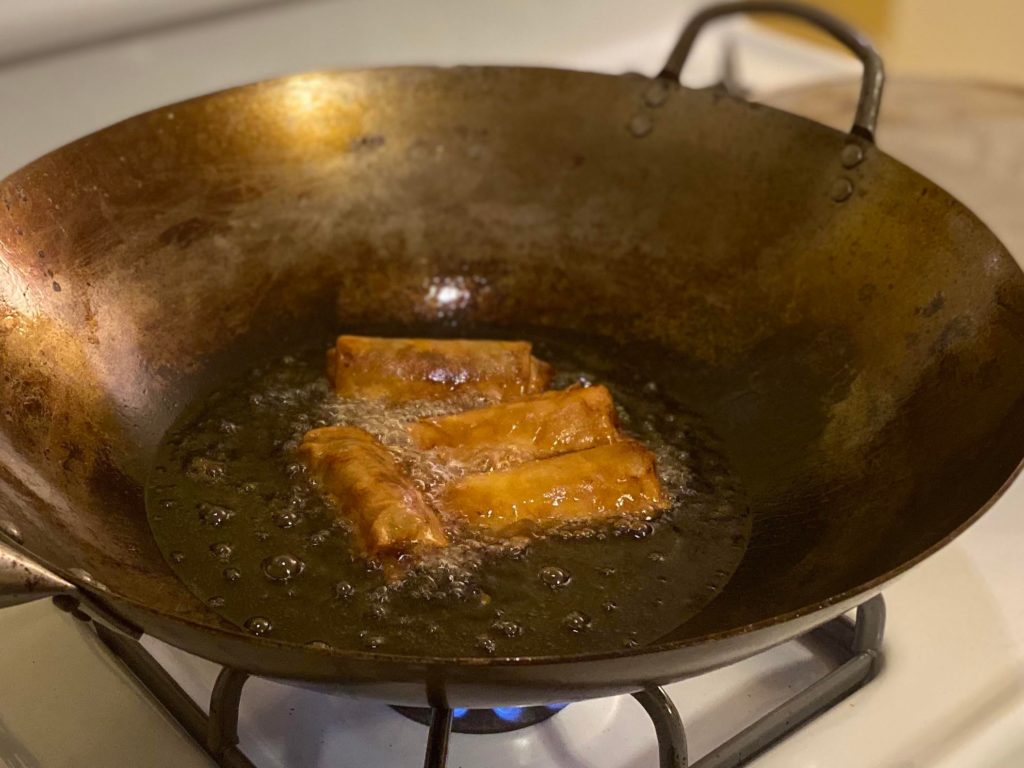
Smoking: unlike standard pans, a carbon steel wok is wide and deep enough to allow for an indoor smoking set-up. This is probably the most ingenious and exotic technique for wok cooking. The spacious interior provides plenty of room for smoke to circulate efficiently around the food.

Cooking pasta: pasta is amongst the best foods you can actually cook in a carbon steel wok. Its space is sufficient for making pasta such as Chicken Alfredo. You don’t need a pot and a pan. You can use your wok to bake or fry your chicken, cook your pasta, simmer your creamy sauce, and then mix all these ingredients together.
Things to avoid when using carbon steel cookware
There are several things you need to bear in mind when it comes to using carbon steel cookware so as to ensure its longevity. You should avoid:
- Soaking it for a long time – water and carbon steel don’t go along very well. This doesn’t mean you can’t use water to cook when using carbon steel cookware. You can certainly do but soaking it in water for a prolonged period of time is a recipe for rust. Use a pan scraper or nylon scrubbing brush if you want to get rid of stubborn stuck-on food but don’t leave the pan sitting in the sink with water.
- Boiling water in it – boiling water can negatively impact the seasoning of your carbon steel cookware, especially when braising or boiling food. The salt in the liquid can cause the seasoning to strip off. So, avoid dishes like stew, soup, or braises if your cookware is newly seasoned. However, when it’s well seasoned and the coating is sufficiently strong, it’s absolutely fine to boil and braise food in it.
- Cooking acidic/alkaline foods in it – acidic foods such as tomato sauce or other dishes that use acidic ingredients like wine, lemon, and vinegar can strip off the seasoning of your carbon steel cookware, leaving it at high risk of rusting over time. If you must cook such foods always try to use your stainless steel or enameled cast iron cookware.
- Using abrasive materials to scrub the cookware – don’t use abrasive materials like steel wool to scrub your cookware when you want to remove stubborn stuck-on food. They will scrub off the seasoning, exposing the surface to moisture and ultimately, rust.
- Drastic temperature changes – rapid temperature changes like from high heat into cold water or from low temp to a high heat can warp your carbon steel cookware. When this happens there’s nothing that can be done to fix it. So avoid this at all costs. You should let the cookware pre-heat gradually over low to medium heat and then raise the temp as it comes to heat. Also, always let it cool gradually after cooking.
How to care for carbon steel cookware
Carbon steel pans and woks require good care for them to keep performing well and there are several ways you can do this, which include:
Seasoning regularly
A carbon steel cookware will require re-seasoning from time to time to ensure it’s in tip top shape and to keep it far from rust. You’ll only have to do this when needed, like when you spot any chipping/flaking off of the patina or any other damage on the cookware. In this case, we recommend re-seasoning it as normal. However, if the remaining patina seems sticky or rough, then give the pan or wok a proper scrub first before starting re-seasoning.
When you wash and dry your cookware, it’s recommended you also apply a layer of seasoning again to ensure extra protection in case the previous coat is worn-out by the cleaning. It’s highly advisable as well to re-season your carbon steel pan after cooking acidic foods in it. .
If you will use an abrasive cleaner like a scouring pad to remove really stuck foods, then you’ll certainly have to re-season the cookware too because you’d have totally damaged the initial seasoning. Failing to do that will no doubt lead to rust.
Removing rust
Rust on a carbon steel cookware is a serious issue, just as it is on cast iron cookware. However, a rusty pan or wok doesn’t mean it’s time to toss it. There are several ways to remove rust from any carbon steel cookware. Some of the most popular ones are:
1. The scouring method
This method is great for getting rid of deeply embedded rust from anywhere on the cookware, including the pesky bottom part of the cookware exterior surface. It involves using a coarse scrubber like a steel wool, a scouring pad, fine grit sandpaper, or an abrasive sponge to forcibly remove the rust from the cookware’s surface. It may seem like it can damage the surface of the cookware, but these coarse sponges will definitely remove the rust without causing damage to the steel and allow you to use your pan or wok again. Once the rust is removed, you rinse the cookware with hot soapy water, dry it completely, and then re-season it.
2. The salt scrub method
This is the least invasive method for rust removal. It involves using oil and coarse salt to scrub off rust from anywhere on the cookware. You pour some coarse salt directly on the rust, followed by oil (vegetable oil or any cooking oil) and then you spread and gently rub the mixture into the rust using a soft cloth or paper towel in small circular motions until all the rust is removed. You then clean, dry, and re-season the cookware or just clean, dry, and store it if the issue is minor. This method is ideal for removing surface rust, mostly small-to-medium-sized rusts spots. It can as well be used on larger rust areas.
3. The vinegar method
This is one of the best methods for not only dealing with heavy interior rust that seems not to go away but also for preventing rust in the future. You just soak your carbon steel cookware in white vinegar and then leave it for about an hour to allow the vinegar to do its magic. White vinegar is generally very powerful in removing rust on steel. It reacts with the rust and dissolves it hence completely getting rid of it from the surface of your cookware.
If you are short on the vinegar, you can just pour it on the cookware and give it time, or even soak a cloth in the vinegar and then wipe the pan with it. You can as well dip aluminum foil in the white vinegar and then use it to clean the cookware’s surface.
Rice vinegar is another good alternative that you can use to get rid of heavy rust on carbon steel cookware, that is, if you can’t get your hands on white vinegar. All you have to do is to mix equal parts of the rice vinegar and water (ratio of 1:1), pour the solution into the cookware, and heat it over medium heat until the mixture boils. You then pour it out and scrub your cookware with warm to medium-hot water and some soap, and rinse it. The rust should be gone. Re-seasoning is needed after this since the vinegar will almost completely strip away your cookware’s built up seasoning.
4. Lemon and Salt Method
This is probably the oldest method in the book and yet another effective option for removing heavy rust. You sprinkle salt on the surface of the cookware (parts that have rusted), then squeeze lime or lemon on it. Give it about four hours to react with rust, and then scrub the cookware using the left-over skin. It’s generally one of the best ways to remove rust without really worrying about destroying your cookware because the combination doesn’t damage the surface. After scrubbing, you clean the cookware thoroughly and then re-season it.
Cleaning carbon steel cookware
Cleaning your carbon steel cookware immediately after use is the best way to keep it safe. The cleaning process itself is quite similar to that of cast iron. To properly do it, you need warm water, a sponge/nylon scrubber, a dish towel, and a clean paper towel.
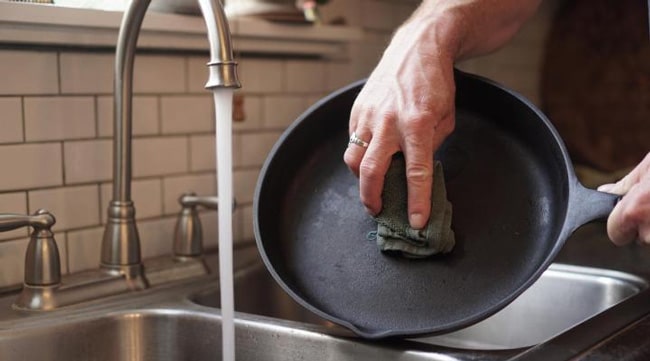
- First, run hot tap water over the dirty carbon steel cookware or put some warm water into it for a few minutes. This will allow the sticking food residues on its surface to soften, after which you then use the sponge/nylon scrubber to remove them. If there are any stubborn bits of food left behind, you can use a non-metallic brush, pan scraper, or a non-scratch pad to gently scrape them off, and then rinse the cookware.
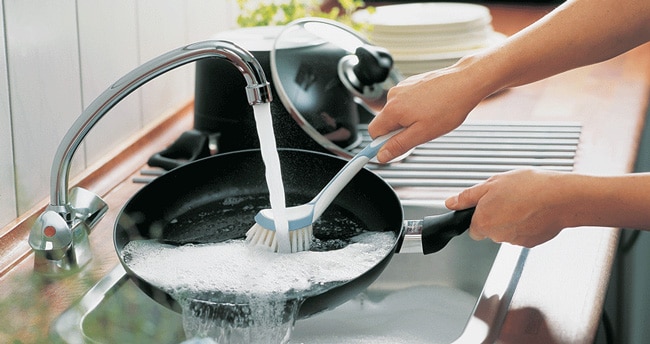
- In case you have some burned food that won’t come off, regardless of how hard you scrub them, then you should deep clean the cookware using the salt scrub method. Heat the cookware on the stove (over medium-high heat) until hot, add a bit of kosher salt and oil and gently rub the surface with a paper towel. Rinse the cookware with hot water in order to clean off the salt.
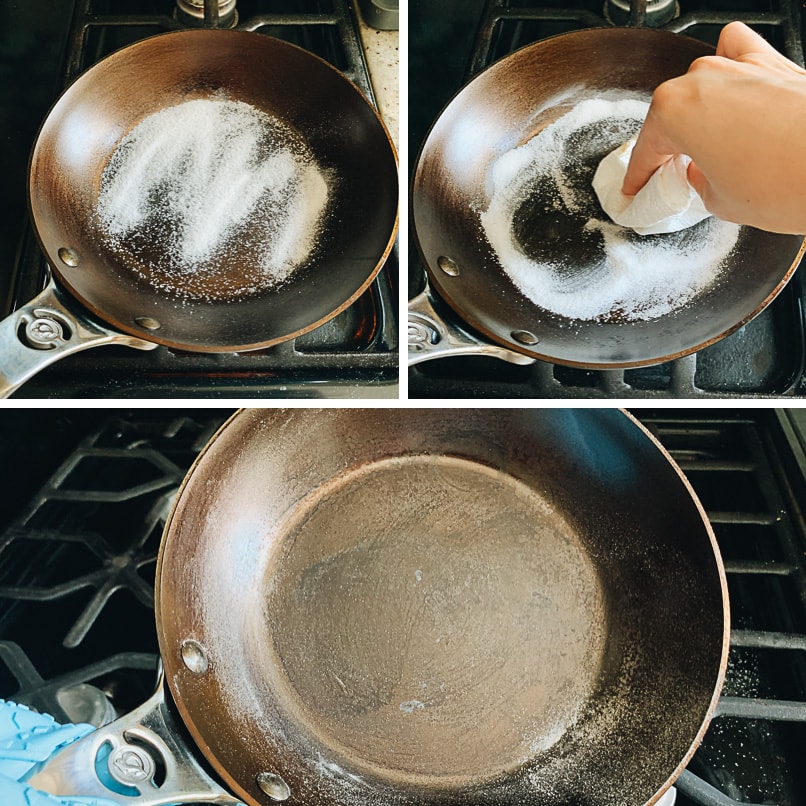
- Once you’re done with washing, dry the cookware inside and out completely. This can be done by use of a dish towel or a clean paper towel and then you heat the cookware slightly over medium heat on a stove for a minute or two to get it bone dry.
- After it gets dry, you can apply some few drops of oil (preferably the same type of oil used to season it) into the interior and brush it until the whole surface is covered evenly with the oil. This will create a very thin coating of oil that will help inhibit rust.
Note: Some brand-new carbon steel pans and woks arrive coated in wax to prevent rusting when stored in the warehouse and during shipping. You must remove this waxy barrier first to clean and season the cookware before you can use it.
Can you use soap to clean seasoned carbon steel cookware?
Keep dish soap or any strong chemical cleaners away from your carbon steel cookware as they can strip the seasoning off your cookware. Your best friend is a soft sponge and just warm water. You can use a small amount of dish soap only to clean the handle if it’s greasy, but avoid getting it inside the cookware.
What about putting the cookware in the dishwasher?
This is a big NO. Like cast iron, carbon steel cookware is not safe to wash in the dishwasher. It should be washed only by hand. The dishwasher will get rid of the seasoning and likely ruin the cookware too.
Storing carbon steel cookware
Before storing a carbon steel cookware, you should dry it thoroughly. Also, if you will be storing the cookware for long periods unused, it’s advisable to oil it well and if possible wrap it in a tea towel.
Most people choose to store their carbon steel cookware by stacking them together which might be beneficial if your kitchen is small. However, you have to place some paper towels between each so as to prevent scratching of the surfaces when they rub against each other.
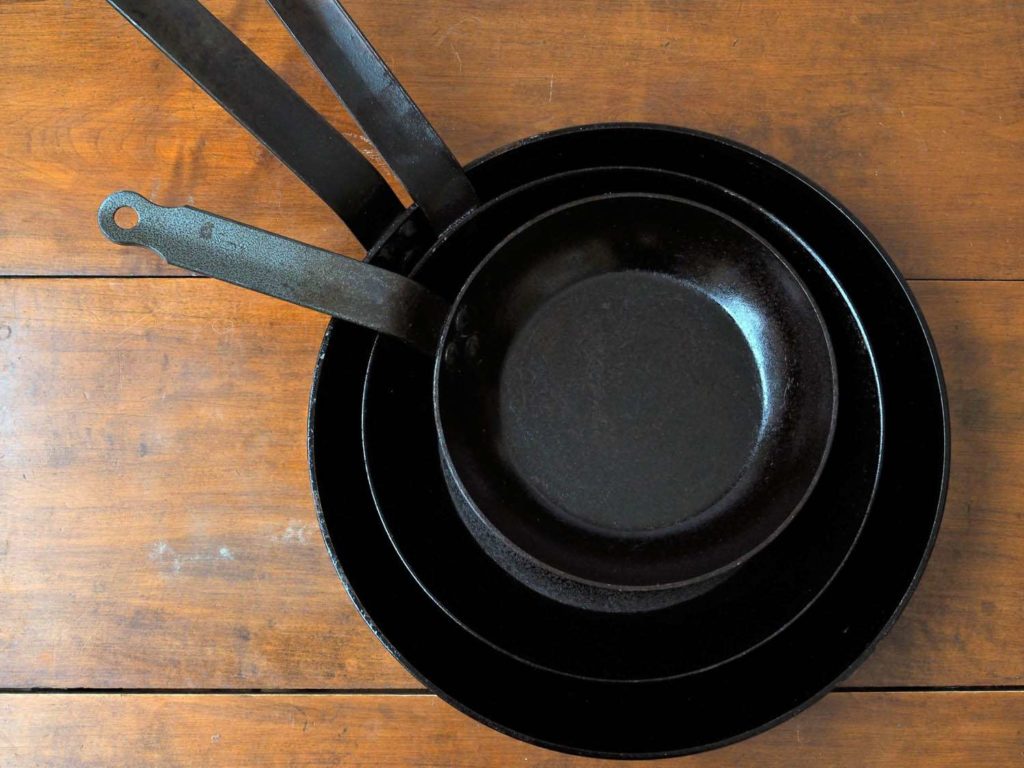
The other option is using a dedicated cookware rack where each piece of your carbon steel cookware can sit on its own spot. A cookware hanging rack or wall hooks is yet another great storage option that can ensure your carbon steel pans and woks don’t get scratches and dents from rubbing or banging against each other or other cookware.
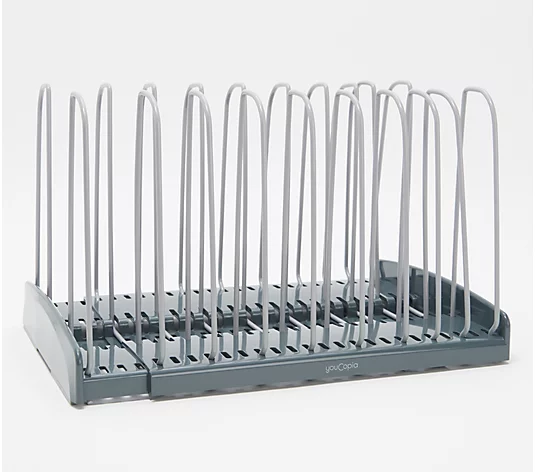
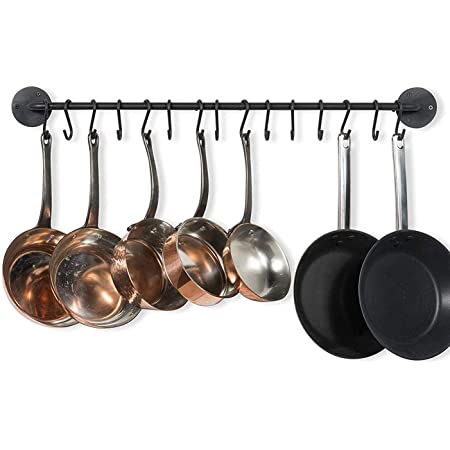
Generally, whatever storage method you choose, the one thing you want to ensure is that the place is completely dry in order to avoid rust. As mentioned earlier, applying a thin coat of oil will equally go a long way to keep rust away, especially if you are not planning to use the cookware for a while or if you live in a humid area.
Advantages of carbon steel over other metals in making cookware
Carbon Steel vs. Cast Iron
carbon steel cookwares heat up quicker and cool down faster than cast iron since they are thinner. They are more responsive to changes in temperature too. However, cast iron cookwares do retain heat better. Both can withstand high temperatures but you risk damaging the seasoning in a cast iron cookware once it goes past 500°F, whereas that of carbon steel cookware is safe all the way to 1200°F. Carbon steel cookware is also lightweight and less brittle than cast iron thanks to its low carbon content. Cast iron cookware is a lot cheaper though and much more available than carbon steel.
Carbon Steel vs. Stainless Steel
both respond to changes in heat fairly well but the stainless steel cookware with a copper core layer offers better responsiveness because of the superior heat conductivity of copper. Heat distribution is better with stainless steel cookware too (especially ones with full-clad construction or an aluminum core). However, carbon steel pans retain heat very well while with stainless steel cookware, heat retention can vary. For instance, a 5-ply stainless pan will retain heat better than a 3-ply one. Carbon steel cookware is also stronger and more durable compared to stainless steel. However, it can corrode and rust quickly when exposed to moisture if care is not taken while stainless steel is rust free due to its high chromium content. Moreover, stainless steel is a less porous and reactive material hence great for acidic foods like tomato-based sauces.
Carbon Steel vs. Aluminum
aluminum cookware is far more popular than carbon steel because it’s more affordable and very lightweight, ideal for repeated use. It has high thermal conductivity (237 W/m K) hence heats up and cools down faster than carbon steel and even distributes the heat more uniformly. It’s resistant to rust and corrosion too, but it’s soft and weak, hence not really durable like carbon steel, plus it can warp when in direct contact with high heat for a long time. Similar to carbon steel though, it’s pretty porous, so it can react with acidic foods or capture and transfer flavors between dishes. You can’t use aluminum cookware on induction cooktops too since aluminum is not magnetic but carbon steel cookware is compatible with induction cooktops along with all the other heat sources.
Carbon Steel vs. Copper
copper cookware offers superior heat conduction than carbon steel or any of the other cookware materials. It heats and cooks faster, hence ideal for finicky recipes that need precise temperature control. However, it’s very reactive hence can leach into the food on direct contact and even discolor it. Copper doesn’t as well retain or withstand very high heat like carbon steel cookware. It also comes at a much higher price point and it’s not strong and durable. It damages quickly compared to carbon steel.
Potential deal breakers
Carbon steel has several notable downsides that could as well be potential deal breakers to some, although it’s the same case with almost all everyday cookware material depending on what exactly you are after. The most notable ones include:
Requires constant maintenance
Carbon steel is highly susceptible to corrosion if not properly looked after, especially if left un-seasoned. Even a single use without proper seasoning can cause the steel to rust quite severely, even when exposed to small amounts of moisture, including the moisture vapor in the air. Besides rust, carbon steel cookware easily becomes blotchy and discolored, which can be a turn off to those after aesthetic appeal like that offered by copper or stainless steel cookware. To keep it in good working order, you have to keep it seasoned every time, which may not be convenient for some people, especially compared to other nonstick cookware.
Not as prevalent as the other cookware types
Another potential deal breaker of carbon steel cookware is the fact that it’s not very common as the other cookware types, like stainless steel or aluminum. When you search online or browse the cookware section in your local department store or kitchen supply store, you won’t really find as many carbon steel cookware options. Most of the well-known cookware brands, including Calphalon and All-Clad, don’t even offer carbon steel.
That’s not to say though that it’s impossible to find carbon steel cookware. It’s not just as common as the rest. You have to really seek it out and be ready and willing to explore some unfamiliar brands, unlike non-stick and stainless steel cookware, which you can easily find everywhere you look. Moreover, there aren’t as many options available as there are with the other materials. They are mostly available as skillets or woks.
Prone to warping
Although it’s strong and durable, carbon steel cookware can warp when cooled or heated too abruptly, which is likely to happen on induction or ceramic-glass cooktops and when you put a hot pan in cold water or run it under the faucet, or place it on a cold countertop. You can avoid this though by preheating your pan gradually on low to medium heat before cranking up the temperature of your induction or ceramic-glass cooktop.
Does it matter where carbon steel cookware is made?
No, it doesn’t matter. Unlike most other types of cookware, carbon steel is just carbon steel. Generally, they are all constructed the exact same way, regardless of the manufacturer. So, they are quite similar across brands, especially in terms of performance and heat retention, unlike stainless steel cookwares, for instance, where the construction tends to vary significantly across brands hence the performance varies too.
Therefore, the question of where exactly a carbon steel cookware is manufactured shouldn’t really pose much concern. However, if you live in the USA and you prefer to shop for your cookware in brick-and-mortar stores, then The Home Depot, Walmart, and Bath & Beyond carry carbon steel pans and woks. However, the best deals are usually found online.
If you live in other locations like Europe, IKEA is a good option. In fact, they make and sell their own carbon steel cookware, which many have attested that they are good enough for daily cooking.
Best brands for carbon steel cookware
We mentioned here that carbon steel cookware is not as prevalent as the other types of cookware and I bet you may be wondering if your options are that limited. That’s not really the case as there are several top brands that offer quality carbon steel cookware. Here are some options you can consider: reputation and price point are the main differences between them.
De Buyer (France)
De Buyer is one of the oldest cookware manufacturers in the world with over 200 years of experience. It’s one of the most sought-after brands and it’s popularly known for its beeswax coating. They were the first to discover it and started coating all their carbon steel cookwares with it. This special coating not only helps to protect De Buyer cookware against oxidation (during storage and transportation) but also helps to enhance seasoning. The company has been improving the quality of its products over years, and it offers a lot more than beeswax. Today, their carbon steel cookware is one of the best out there. The company produces high-quality cookwares which are versatile and highly durable making them popular among chefs. Their main target market is professionals and people who are very serious about home cooking. All the company’s products are manufactured in France.
Mafter Bourgeat (France)
Mafter Bourgeat was established in 1814, making it another very old cookware brand in the list. Their carbon steel cookware is impressive and it’s specifically designed for professional Chefs. The company offers a wide range of sizes which you can choose according to your preferences. Regardless of the size, the functionality and quality of all Mafter Bourgeat carbon steel pans is the same. All their products are produced in France.
Lodge (USA)
started in 1896, Lodge is amongst the oldest known cookware brands in America. The company focus has been mainly cast iron cookware and it only introduced their line of carbon steel cookware in 2013. Despite being a bit of latecomers in this industry, their carbon steel skillets are of excellent quality and come pre-seasoned. They are practically nonstick and easy to clean. Their sizes range from 8 to 15 inches. All cookware varieties from skillets to woks are made in America.
Mauviel (France)
founded by Mr. Ernest Mauviel in 1830 in a village called Villedieu-Les-Poeles in France, Mauviel is a well-known name in the cookware industry. The company is mainly known for its copper cookware but like Lodge, it recently started manufacturing carbon steel cookwares that are getting rave reviews for their great heat conduction and durability.
Craft Wok (China)
Craft Wok is a Chinese company that has made its name amongst stir fry and wok enthusiasts. Its range of branded products is made of authentic traditional carbon steel. Its woks come in an array of styles that you can choose according to your preferences. They conduct and retain heat very well, and come pre-seasoned. The handles have either a silicone grip or a stay-cool wooden attachment.
Winco (Spain)
Winco is a Spanish brand that’s known for making high quality and low-cost carbon steel cookware that hold up well to high temperatures making them suitable for searing. Their cookwares also have sturdy, riveted handles and come pre-seasoned hence you can use them right out of the box once you wash them.
Garcima (Spain)
Garcima is another Spanish brand that makes quality carbon steel cookware. Its cookwares are quite rigid and durable, having a hammered dimpled bottom which spreads the heat evenly and quickly and also gives them a beautiful look. Garcima carbon steel cookware handles are made of steel and come painted in different colors. They can be used in an oven, on a stovetop, open flame, or even on a gas barbeque grill.
BK cookware (China)
BK was founded back in 1851 and they are actually the inventors of the famous Dutch oven. The company is known throughout the world for its heritage of innovation. Their carbon steel cookwares come pre-seasoned and their handles are made of cast iron, offering a firm, secure grip. They have a thin silicon wax coating which is easier to remove than grease or De Buyer’s beeswax.
Made In (France)
Made In was launched in 2016. It’s the brainchild of Jake Kalick and Chip Malt, longtime friends who saw a vast opportunity in a slowly growing industry. The company outsources their raw materials and manufactures its products through other family-owned businesses in America, France, and Italy. Their carbon steel cookware production is done in France with a company which has been crafting carbon steel cookware for centuries. Their products are of great quality, but don’t come pre-seasoned hence need seasoning before use.